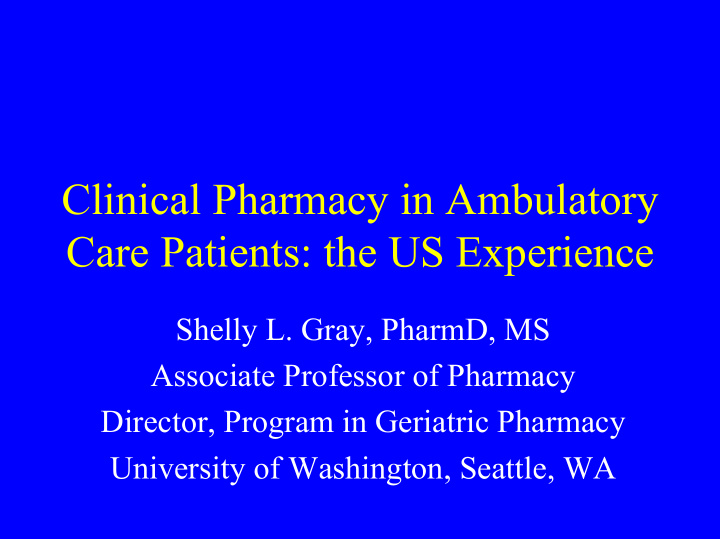



Clinical Pharmacy in Ambulatory Care Patients: the US Experience Shelly L. Gray, PharmD, MS Associate Professor of Pharmacy Director, Program in Geriatric Pharmacy University of Washington, Seattle, WA
Substance Abuse Among Older Adults • Treatment Improvement Protocol (TIP) Series 26 • Frederick C. Blow, PhD, Consensus Panel Chair • DHHS Publication No. (SMA) 02-3688 • Reprinted 2002
Description of Clinical Site: PACE • Program of All Inclusive Care for the Elderly • 40 PACE programs across the United States • Provide comprehensive health care and social services including: – primary and specialty medical care – day health program – social work services – prescription medications
Description of Participants • At least 55 years old • In need of nursing facility level of care as defined by: – needing extensive assistance with 2 activities of daily living (ADLs) , OR – minimal assistance with 3 ADLs – ADLs include eating, toileting, ambulation, transfer support, bathing and self-medication.
Description of Participants • ~150 participants • Similar to the average nursing home resident, on average she is: – 80 years old – 8 medical conditions – limited in approximately 3 ADLs • 49% have been diagnosed with dementia
Role in Clinic • Provide consultation ½ day per week onsite • Review participant medication regimen – Upon entry into program – Every six months coinciding with interdisciplinary team review • Reduce drug costs • Provide health care provider education • Communicate with participant, caregiver or facility staff to resolve medication related issues.
Participant Medication Review Process • Review conducted 3 weeks prior to the interdisciplinary team assessment meeting • Review medical chart – Physician and other health care provider notes – Discharge notes from prior hospitilizations – Medication changes over past 6 months – Pertinent lab values • Develop written recommendations which is routed to the physician and then placed in chart
Emphasis of Medication Review • Assess appropriateness of therapy • Detect and correct undertreatment of conditions • Identify undetected medication-induced problems • Reduce psychoactive medication use when possible
Participant Medication Review Assess appropriateness of therapy • Indication • Effectiveness • Appropriate dosing • Cost effective • Drug-drug interactions • Drug-disease interactions
Participant Medication Review Detect and correct undertreatment • Secondary prevention for heart attack and stroke – Aspirin for patients with heart disease – ACE inhibitor use in congestive heart failure – Beta blocker use in congestive heart failure or after heart attack • ACE inhibitor use in hypertension and renal insufficiency • Osteoporosis management – Calcium, vitamin D, bisphosphonates
Participant Medication Review Other Issues • Identify undetected medication-induced problems – Any adverse drug reaction – Geriatric syndromes • Falls • Memory impairment • Urinary incontinence • Reduce psychoactive medication use – Trazodone use for sleep – Atypical antipsychotics and mood stabilizers for behavioral problems due to dementia
Case Example DD is a 75 year old white female with chronic pain who presents with a one year history of declining functional status and frequent falling episodes. She is newly enrolled in the program.
Case Example • Medical History – Back pain (multiple sources, osteoarthritis) – Osteoporosis with vertebral fractures – Hypertension – Type 2 diabetes – Overactive bladder with urinary incontinence (pretty well controlled) – Coronary artery disease (s/p MI 5/04)
12 Medications ! Zolpidem 10 mg qhs Pain medications Glyburide 10 mg bid • Propoxyphene/APAP (100/650) q 6 hr (4-5/day) HCTZ 25 mg qd • Cyclobenzaprine 10 mg Amlodipine 5 mg daily TID Oxybutynin 5 mg TID • Tylenol with codeine #3 Benadryl 50 mg qhs prn (3-4/day) Vitamin E 400 U daily • Glucosamine sulfate 500 Calcium carbonate 500 mg mg TID as needed BID
Potentially Inappropriate/Unnecessary Drugs? Zolpidem 10 mg qhs Pain medications Glyburide 10 mg bid • Propoxyphene/APAP (100/650) q 6 hr (4-5/day) HCTZ 25 mg qd • Cyclobenzaprine 10 mg Amlodipine 5 mg daily TID Oxybutynin 5 mg TID • Tylenol with codeine #3 Benadryl 50 mg qhs prn (3-4/day) Vitamin E 400 U daily • Glucosamine sulfate 500 Calcium carbonate 500 mg mg TID as needed BID
Undertreatment • CAD – Add daily aspirin • Post-MI – Add beta-blocker – Add Ace-inhibitor • Osteoporosis – Increase calcium supplementation (400 mg from current supplement, 300 mg from diet). – Add Vitamin D 600-800 IU – Consider bisphosphonate
Medication-Induced Problems ? • Falls and impaired function – Cyclobenzaprine, diphenhyradamine – Zolpidem (J Am Geriatr Soc 2001;49:1685-90)
Goal: Reduce Drug Costs • Work with pharmacy provider to determine which medication is most cost effective within a therapeutic class • Communicate this information on regular basis to physicians to ensure prescribing of most cost effective medication • Example: statins for lowering lipid levels
Why Is This Relationship Successful? • Employed by PACE program • Work collaboratively with 2 physicians in program to identify focus for my activities. • Major goal is to improve patient care and reduce drug costs if possible.
Recommend
More recommend